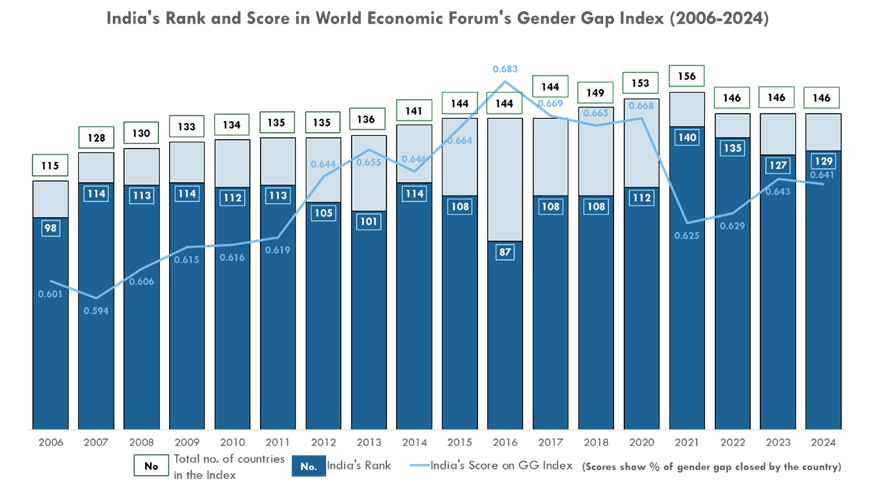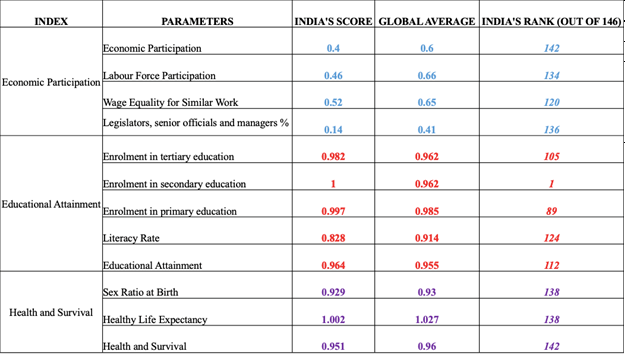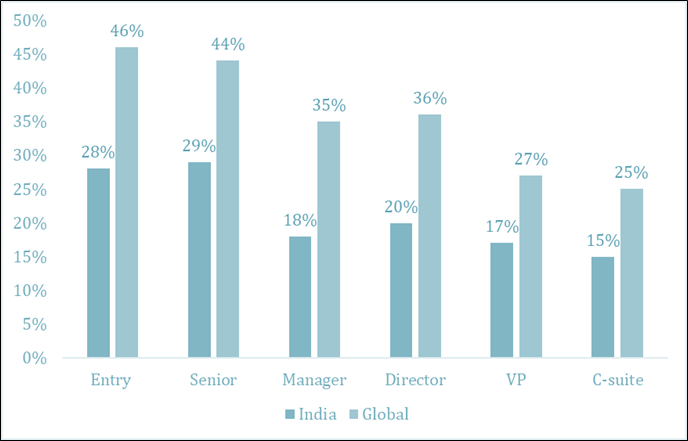|
|
The World Economic Forum recently released its annual Global Gender Gap Index (2024) and ranked India 129th out of 146 countries, slightly lower than its 2023 position. Despite being the world's fastest-growing economy and the fifth-largest in terms of GDP, Indian women seem to be missing out on the country's remarkable growth story. While it will take the world an estimated 134 years (about five generations) to reach full gender parity, for South Asia and India, this could take seven generations or roughly 170 years!
This situation appears counterintuitive given the array of measures implemented by the Indian Government under its “Women-led Development” initiative and the recent increase in India’s female labour force participation rate. It also does not reflect the high proportion of women in at India’s local governance, the reversal of gender gaps in school enrolment, or the achievements in curtailing maternal mortality rates.
The contradiction stems from the fact that while India has made notable progress in bridging gender gaps, this progress has been slower than global trends. India has closed 64.1% of its gender gaps in 2024, an improvement from 60.1% in 2006 (Figure 1) but a decline from 68.3% in 2017 caused by the COVID-19 pandemic that the country has not yet completely recovered from.
Figure 1: India vs the World: Scores on the Gender Gap Index

Source: WEF Gender Gap Report Dashboard
India's Gender Gap: A Breakdown by Sub-Index
An analysis of India’s performance on the Gender Gap Index’s four sub-indices (Figure 2) reveals that since 2014, significant improvement in the Educational Attainment Index has driven the overall gender gap index upward. The Political Empowerment Index also contributed positively to the overall scores until 2015. Additionally, the Economic Participation Index has shown an uptrend since 2022, ensuring a continuous, albeit slow, improvement in India’s overall gender gap score.
Figure 1: India’s Scores on the 4 Sub-Indices of Gender Gap Index

Source: WEF Gender Gap Report Dashboard
The Political Empowerment Index for India has been declining after continuous improvement from 2006 to 2020, primarily driven by an increase in the share of women in Parliament. However, after 2020, the performance on the “proportion of women in ministerial positions” dropped sharply. Additionally, the “years with a female head of state in the last 50 years” parameter has decreased annually as the tenure of the female Prime Minister ended in 1984 (Table 1).
Table: Analysis of India’s Performance on the Political Empowerment Index

Source: WEF Gender Gap Report Dashboard
India's score on the Economic Participation Index is the fourth lowest in the world in 2024, reverting to its 2006 level of 0.40 after peaking in 2012 at 0.46. One reason for the low score is that India has closed 20% less of the labour force participation gender gap compared to the world average. However, more concerning is that India has only closed 14% of its leadership gender gap, compared to the global average of 41% (Table 2).
On the Educational Attainment Index, India has performed better than the World average. It has fully closed the gender gap in primary and secondary enrolment, and almost completely in tertiary education. However, the literacy rate gender gap has only been closed by 82.8% (Table 2).
On the Health and Survival Index, India has closed about 95% of its gender gap as compared to the 96% World average but is ranked 142nd out of 146 countries (Table 2). Despite the significant decline in India’s maternal mortality rates and improved sex ratios, its relative score on the health index has remained constant.
Table 2: Analysis of India’s Performance on the Economic Participation Index, Educational Attainment Index & Health and Survival Index (2024)

Source: WEF Gender Gap Report Dashboard
How Can We Accelerate the Process of Closing India’s Gender Gaps?
Gender gaps in economic, social, and political spheres are persistent across the globe, but comparative statistics show that India still fares worse than most other countries. Based on the analysis of the gender gap index, the following large-scale measures can help India significantly improve its score and rank on the gender gap index:
Implement voluntary party quotas and improve financing of women candidates to increase the proportion of female decision-makers in the Lok Sabha
While most gains would come from appointing a Female Prime Minister but even raising the proportion of women in Parliament and at the Ministerial level will directly amplify India’s scores on both Political Empowerment and Economic Participation indices. Indirectly, higher female representation in government would lead to improved health, social and economic outcomes. The imminent implementation of the Women’s Reservation Bill could increase the share of women in Parliament to 33%, but it would also be enabled by implementing voluntary gender quotas by political parties, training and financing women with political aspirations and making Government departments “women-friendly” employers.
Create the right organisational cultures that promote and enable women’s leadership aspirations
India's corporate workforce has fewer women leaders than the global average (Figure 3). Elevating more women to leadership positions would directly improve India’s score on the Economic Participation Index and have broader benefits for gender equality. This would require supporting women at all stages of their personal and professional journeys and providing flexibilities like parental leave and work-from-home to both women and men to prevent women from paying the “motherhood penalty”. It would also require gender-sensitive evaluation and appraisal of women’s work; exposing women to successful female leaders as relatable female role models and mentors; and sponsoring structured leadership development programs for women that support them in building their leadership competencies.
Figure 3: Representation of Women in the Corporate Workforce

Source: LinkedIn Economic Graph
India's corporate workforce has fewer women leaders than the global average (Figure 3). Elevating more women to leadership positions would directly improve India’s score on the Economic Participation Index and have broader benefits for gender equality. This would require supporting women at all stages of their personal and professional journeys and providing flexibilities like parental leave and work-from-home to both women and men to prevent women from paying the “motherhood penalty”. It would also require gender-sensitive evaluation and appraisal of women’s work; exposing women to successful female leaders as relatable female role models and mentors; and sponsoring structured leadership development programs for women that support them in building their leadership competencies.
Reduce women’s care burden, upskill, and provide them opportunities to increase their workforce participation
To improve Economic Participation outcomes, efforts must be made to enhance women’s ability to find employment, to stay in the workforce and be compensated fairly. To enable this, employers must implement India’s Labour Ministry’s recently released Advisory to employers for promoting gender equality and women's workforce participation. In addition, urgent measures are required to redistribute unpaid care work equitably, such as implementing paternity leave policies, enhancing the regulated paid-care ecosystem and enabling men to become better caregivers. Educated women must also be provided with employable skills and opportunities to build businesses, perform higher-productivity jobs and occupy leadership positions.
Build an equitable education system while maintaining school enrolment figures
Beyond maintaining current enrolment rates at the primary, secondary, and higher education levels, the New Education Policy and curriculum must also be made enabling and equitable to impact mindsets and break patriarchal norms. Additionally, attracting more women to enroll in professional, technical, and engineering colleges and programs will be crucial for closing the remaining gaps in tertiary education and workforce participation.
Such large-scale, focused programs and schemes can significantly address gender barriers, as demonstrated by India's successful reforms that have bridged gender gaps in primary and secondary education. However, while these measures are crucial, they alone are insufficient to fully include Indian women in the country's growth narrative. It is essential to go beyond the "Women-led Development" initiatives and integrate gender concerns into all of India’s core macroeconomic policies. This comprehensive approach will ensure that economic policies benefit both men and women equally.